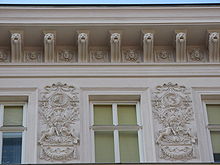Doblhoffgasse
| Doblhoffgasse | |
|---|---|
| Street in Vienna Inner City | |
| Basic data | |
| place | Vienna Inner City |
| District | Inner city |
| Created | 1873 |
| Cross streets | Reichsratsstrasse , Bartensteingasse , Rathausstrasse , Landesgerichtsstrasse |
| use | |
| User groups | Pedestrian traffic , bicycle traffic , car traffic |
| Road design | partly pedestrian zone |
| Technical specifications | |
| Street length | approx. 170 meters |
The Doblhoffgasse located on the 1st Viennese district of Inner City . It was named in 1873 after the politician Anton von Doblhoff-Dier .
history
The area in which Doblhoffgasse is located today was originally part of the undeveloped glacis in front of the Vienna city walls . In the 19th century this was the parade and parade ground until 1870. Then the decision was made to block the free area and to create the town hall district around the new Vienna City Hall . In the course of this planning, Doblhoffgasse was created in 1873.
Location and characteristics
Doblhoffgasse runs from Reichsratsstrasse behind Parliament in the east to Auerspergstrasse in the west. From Bartensteingasse it is a dead end and from Rathausstrasse it is a pedestrian zone , so that it can only be used continuously by bike. The entrance to an underground parking garage is located between Bartensteingasse and Rathausstrasse. Apart from the office building number 10, the building is uniformly late historical .
building
number 2
The side entrance of the arcade building at Reichsratsstrasse 7–9, built in 1883–84 by Franz von Neumann in a late historical style.
Number 3
The corner house on Bartensteingasse (No. 6) was built in 1874–1875 by Wilhelm Stiassny . The strictly historical building shows the forms of the Viennese Neo-Renaissance . The facade is emphasized by a corner projectile . The pilaster-structured driveway shows grotesque paintings and spandex figures .
The main association of sworn and court-certified experts has its headquarters in the building.
Number 5-9
The important building block (also known as the Bartenstein block) was built in 1873–1874 by Josef Hudetz and Moritz Hinträger . The building Doblhoffgasse 7 is noteworthy, which stands out from the other buildings because it is the oldest example of Viennese architecture with old German forms. It has a bay window and an attic gable, the entrance is blasted segment gable. The free-standing block is at Bartensteingasse 1–5.
The Embassy of Georgia is in house number 5 .
Number 6
The strictly historical corner house, which was built by Hörner & Dantine in 1877, was originally a girls' school. Its facade shows giant Ionic pilasters and 2 pilaster portals with female statues. There are keystones set with putti on the ground floor. Today the building is the seat of the City of Vienna - Wiener Wohnen .
Number 10
The modern office building and data center of the City of Vienna was built from 1976 to 1980 by Harry Glück , Werner Höfer and Tadeusz Spychała in reinforced concrete with a glass facade. It is located at Rathausstrasse 1. Until 2013, it housed the data center of the City of Vienna. The building is to be demolished and replaced by a new building in 2015.
literature
- Federal Monuments Office (ed.): Dehio-Handbuch Wien. I. District - Inner City . Berger, Horn 2003
Web links
Individual evidence
- ↑ Data center is being torn down ( memento of the original from February 23, 2014 in the Internet Archive ) Info: The archive link was automatically inserted and not yet checked. Please check the original and archive link according to the instructions and then remove this notice. . Wienerzeitung dated December 11, 2013 (online, accessed February 11, 2914).
Coordinates: 48 ° 12 ′ 30.1 ″ N , 16 ° 21 ′ 23 ″ E




